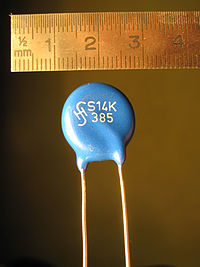
Photo from wikipedia
An electrochemical zinc oxide (ZnO) pH sensor is proposed and prototyped using a flexible printed circuit board (FPCB). The device is resistant to acidic and alkaline solutions and exhibits excellent… Click to show full abstract
An electrochemical zinc oxide (ZnO) pH sensor is proposed and prototyped using a flexible printed circuit board (FPCB). The device is resistant to acidic and alkaline solutions and exhibits excellent electrical conductivity. The sensing film was deposited by radio-frequency sputtering, providing a dense ZnO layer, and (3-aminopropyl)triethoxysilane (APTES) was used to enhance the chemical stability of the ZnO in acidic solutions. The proposed pH sensor has an average sensitivity of 37.52 mV/pH, linearity of 0.995, and a repeatable RSD value of 2.4%. Testing was conducted with Carmody’s buffer pH 2–10 and a voltage-time measurement system. The stability of the prototype was determined by the measurement of the drift and hysteresis effects.
Journal Title: IEEE Access
Year Published: 2022
Link to full text (if available)
Share on Social Media: Sign Up to like & get
recommendations!